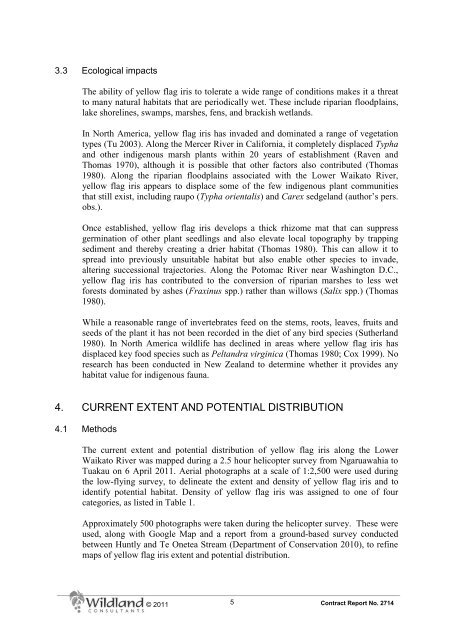Current Extent and Potential Distribution of Yellow Flag Iris in
Current Extent and Potential Distribution of Yellow Flag Iris in
Current Extent and Potential Distribution of Yellow Flag Iris in
Create successful ePaper yourself
Turn your PDF publications into a flip-book with our unique Google optimized e-Paper software.
3.3 Ecological impactsThe ability <strong>of</strong> yellow flag iris to tolerate a wide range <strong>of</strong> conditions makes it a threatto many natural habitats that are periodically wet. These <strong>in</strong>clude riparian floodpla<strong>in</strong>s,lake shorel<strong>in</strong>es, swamps, marshes, fens, <strong>and</strong> brackish wetl<strong>and</strong>s.In North America, yellow flag iris has <strong>in</strong>vaded <strong>and</strong> dom<strong>in</strong>ated a range <strong>of</strong> vegetationtypes (Tu 2003). Along the Mercer River <strong>in</strong> California, it completely displaced Typha<strong>and</strong> other <strong>in</strong>digenous marsh plants with<strong>in</strong> 20 years <strong>of</strong> establishment (Raven <strong>and</strong>Thomas 1970), although it is possible that other factors also contributed (Thomas1980). Along the riparian floodpla<strong>in</strong>s associated with the Lower Waikato River,yellow flag iris appears to displace some <strong>of</strong> the few <strong>in</strong>digenous plant communitiesthat still exist, <strong>in</strong>clud<strong>in</strong>g raupo (Typha orientalis) <strong>and</strong> Carex sedgel<strong>and</strong> (author’s pers.obs.).Once established, yellow flag iris develops a thick rhizome mat that can suppressgerm<strong>in</strong>ation <strong>of</strong> other plant seedl<strong>in</strong>gs <strong>and</strong> also elevate local topography by trapp<strong>in</strong>gsediment <strong>and</strong> thereby creat<strong>in</strong>g a drier habitat (Thomas 1980). This can allow it tospread <strong>in</strong>to previously unsuitable habitat but also enable other species to <strong>in</strong>vade,alter<strong>in</strong>g successional trajectories. Along the Potomac River near Wash<strong>in</strong>gton D.C.,yellow flag iris has contributed to the conversion <strong>of</strong> riparian marshes to less wetforests dom<strong>in</strong>ated by ashes (Frax<strong>in</strong>us spp.) rather than willows (Salix spp.) (Thomas1980).While a reasonable range <strong>of</strong> <strong>in</strong>vertebrates feed on the stems, roots, leaves, fruits <strong>and</strong>seeds <strong>of</strong> the plant it has not been recorded <strong>in</strong> the diet <strong>of</strong> any bird species (Sutherl<strong>and</strong>1980). In North America wildlife has decl<strong>in</strong>ed <strong>in</strong> areas where yellow flag iris hasdisplaced key food species such as Pelt<strong>and</strong>ra virg<strong>in</strong>ica (Thomas 1980; Cox 1999). Noresearch has been conducted <strong>in</strong> New Zeal<strong>and</strong> to determ<strong>in</strong>e whether it provides anyhabitat value for <strong>in</strong>digenous fauna.4. CURRENT EXTENT AND POTENTIAL DISTRIBUTION4.1 MethodsThe current extent <strong>and</strong> potential distribution <strong>of</strong> yellow flag iris along the LowerWaikato River was mapped dur<strong>in</strong>g a 2.5 hour helicopter survey from Ngaruawahia toTuakau on 6 April 2011. Aerial photographs at a scale <strong>of</strong> 1:2,500 were used dur<strong>in</strong>gthe low-fly<strong>in</strong>g survey, to del<strong>in</strong>eate the extent <strong>and</strong> density <strong>of</strong> yellow flag iris <strong>and</strong> toidentify potential habitat. Density <strong>of</strong> yellow flag iris was assigned to one <strong>of</strong> fourcategories, as listed <strong>in</strong> Table 1.Approximately 500 photographs were taken dur<strong>in</strong>g the helicopter survey. These wereused, along with Google Map <strong>and</strong> a report from a ground-based survey conductedbetween Huntly <strong>and</strong> Te Onetea Stream (Department <strong>of</strong> Conservation 2010), to ref<strong>in</strong>emaps <strong>of</strong> yellow flag iris extent <strong>and</strong> potential distribution.© 20115Contract Report No. 2714
















